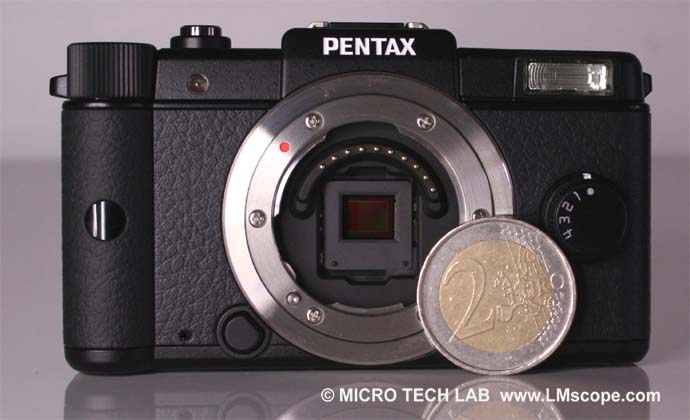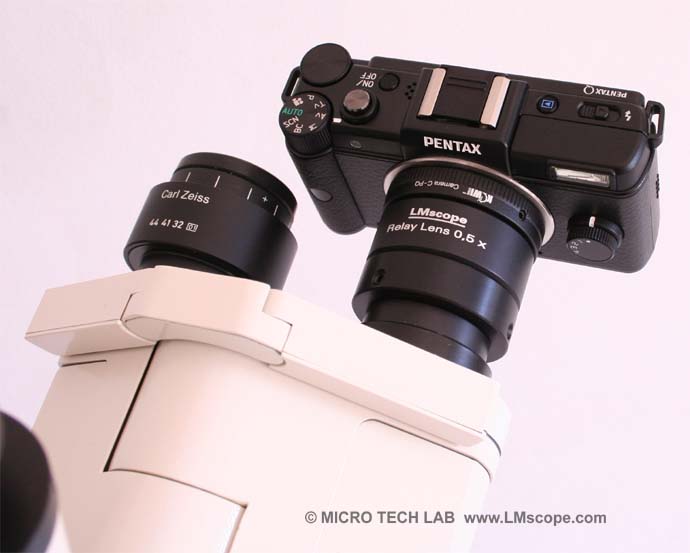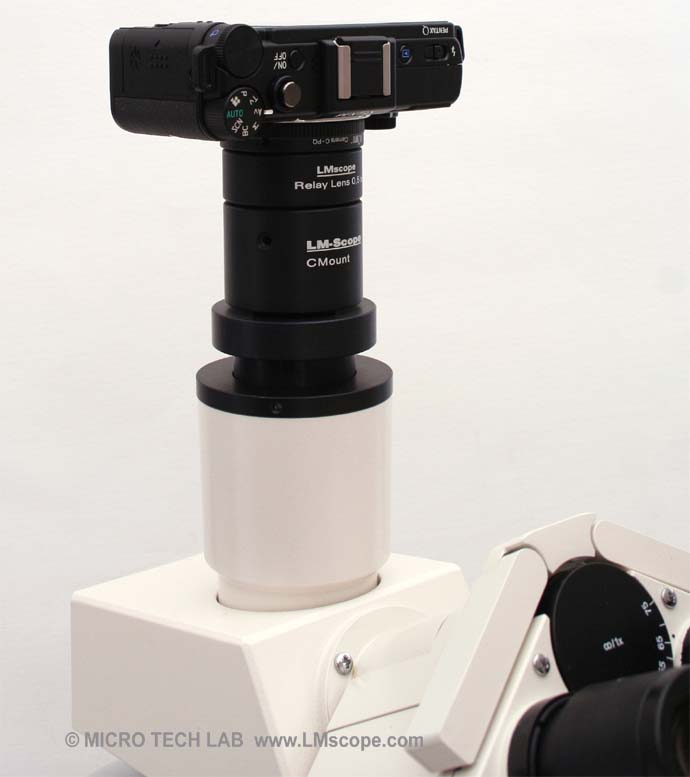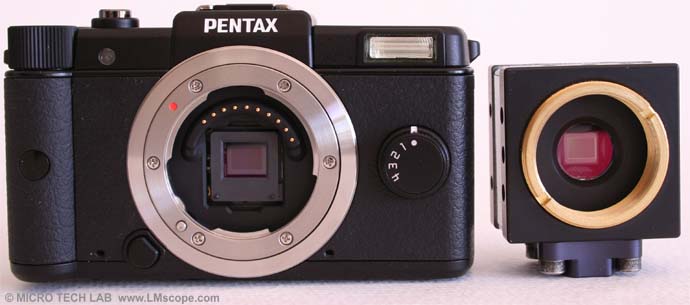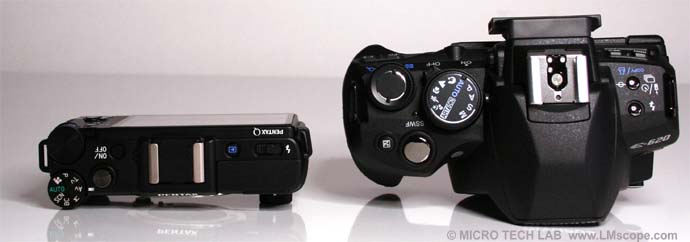

Pentax Q - how does the “midget” with an interchange lens mount system perform when used on a microscope?
The particularly small design of the Pentax Q and its tiny sensor have made us curious about whether the camera is advisable for microscopy. The fact that the 1/2.3” CMOS sensor is only slightly smaller than the usual 1/2” sensors in C-mount microscope cameras is enough to spark the interest of any microscope enthusiast.
The Pentax Q seems like a toy camera. However, despite its diminutive weight of just 200 grams, it is still very well built. Almost all of the back panel is taken up by the 7.5 cm display, but using the buttons is no problem, even for male users with larger hands, especially not in this age of smartphones and other electronic gadgets.
In comparison with other system cameras (Sony NEX series, Olympus Pen) with APS-C sensors, the sensor used in the Pentax Q is very small. As a result, signal-to-noise ratio is clearly inferior, but the the colour depth (36 bit) is the same. This means that the image quality declines significantly when higher ISO levels are used.
The Pentax Q (just the camera housing) is very simple to attach to a microscope (in our case: Zeiss Axioskop).
(image on the left) We needed a CMount_PentaxQ , a Relaylens05TC and a TUST30W to mount the Pentax Q onto the eyepiece tube, because our Zeiss Axioskop has a tube diameter of 30 mm.
(image on the right) On the phototube, we needed a CMount_PentaxQ, a RelayLens05TC, a TUST37C and an Interface44.
We immediately noticed that the camera does not enable feeding the Live View image to the HD monitor via the HDMI cable. For this reason, it is not easily possible to control the Live View image from an external monitor. But the camera has an analog video output for Live viewing, but the picture quality is not too good. Image and video display is supported only in the replay mode. That is a very important function in microscopy, however, which significantly streamlines the workflow and thus increases productivity. We also miss the magnifying function in Live View mode, which is an essential feature in microscopy because it enables precise adjustment of the focal plane. But from firmware version 1.10 the magnifying function in Live View mode is possibile in two steps (2x and 4x).
To be able to work ergonomically, you should definitely also purchase a display mirror: the camera’s own monitor is not movable, so otherwise you would end up twisting yourself into knots to adjust the image controls.
Another function that is important for microscopy is the continuous advance mode. The Pentax Q takes 5 frames per second, but only for a duration of 1 second. If you reduce the speed to 1.5 frames/second, more shots are possible. The maximum video resolution is 1,920 x 1,080 pixels (full HD) at 30 frames per second.
We are also excited about the interval function that takes images at user-definable regular intervals, which makes shooting time-lapse series particularly easy.
The colour deviations already mentioned in other reports also caught our eye (e.g. orange and yellow look a bit greenish, etc.).
Conclusion:
The Pentax Q is suitable for microscopy only to a limited extent. One major shortcoming is the absence of a magnifying function in Live View mode (but from firmware version 1.10 the zoom function is available in two steps). However, the camera is definitely useful for microscopes that have only one C-mount port (with a factor of 0.5x) that is not interchangeable. In such cases, it is very easy to upgrade from a C-mount camera to system cameras.
Wishlist to Pentax:
Zoom function in Live View mode (from firmware version 1.10 available) and feeding the Live View image to the HD monitor via the HDMI cable.
Please look at our test review about the Pentax Q in macroscopy use here!
12.06.2012
New LM Digital Adapter for: Pentax K-1 Mark II / Pentax KP / Pentax K-5 / Pentax K-3 II / Pentax K-500 / Pentax K-S2 / Pentax K-r / Pentax K-5 II / Pentax K-5 IIs / Pentax K-3 / Pentax K-50 / Pentax K-S1 / Pentax K-x / Pentax K-70 / Pentax K-7 / Pentax RS1000 / Pentax RZ10 / Pentax RS1500 / Pentax S1 / Pentax A40 / Pentax S12 / Pentax X70 / Pentax Optio P70 / Pentax Optio P80 / Pentax Optio W80 / Pentax Optio H90 / Pentax Optio I-10 / Pentax Optio W90 / Pentax Optio X90 / Pentax M60 / Pentax E60 /
